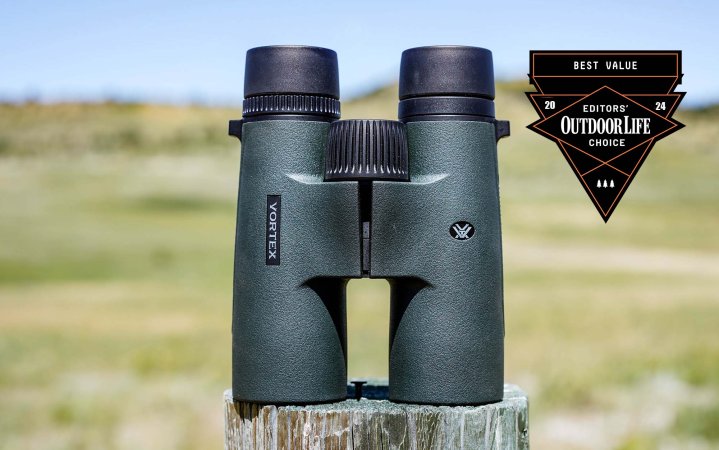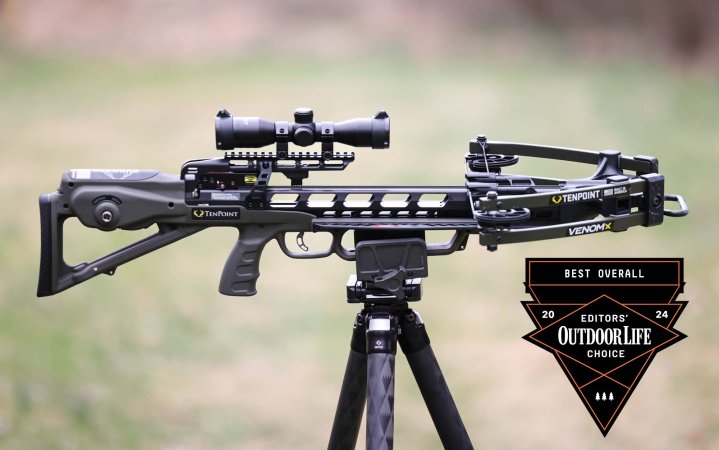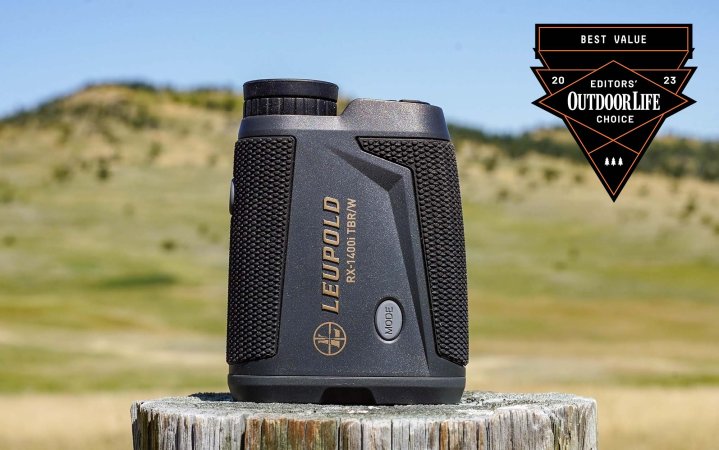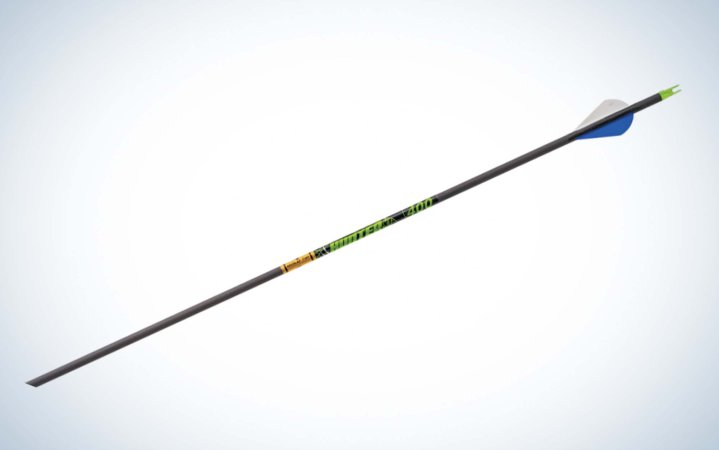We may earn revenue from the products available on this page and participate in affiliate programs. Learn More ›
At Outdoor Life we test hundreds of products throughout the year including optics, bows, trail cams, rifles, and even EDC gear. In our head-to-head gear tests we award an editor’s choice winner for the best performing product, regardless of price. We also give an award for products that provide a lot of value for your hard-earned dollar. Here are seven pieces of budget bowhunting gear we’ve tested that outperform their purchase price and are worth buying for this season.
- Trail Camera: Moultrie Mobile Edge ($100 for a two pack)
- Binocular: Vortex Triumph HD 10×42 ($90)
- Compound Bow: Bear Alaskan XT ($630, includes accessories)
- Crossbow: Tenpoint Venom X ($1,100)
- Rangefinder: Leupold RX-1400i TBR/W Gen2 ($150)
- Tree Saddle: Tethrd Grit Workhorse Saddle Kit ($300, includes accessories)
- Broadhead: Magnus Stinger ($40)
- Arrow: Gold Tip Hunter XT ($70 for six fletched arrows)
Trail Camera: Moultrie Mobile Edge
Pros
- Powerful app with lots of features
- Easy setup
- Affordable for a cell cam
Cons
- Slightly slower trigger speed
Key Features
- Automatically pairs with most powerful cellular network
- 0.85 second trigger speed
- Advertised Detection Range: 80 feet
- Free unlimited cloud storage
- Internal memory (no SD card)
- SmartTags for species and buck recognition
- 16 AA Batteries
- Price: $80 (plans start at $9.99 monthly)
The Moultrie Mobile Edge won “most powerful app” in our annual trail cam test, and it’s also an insane value. You can get a two pack for $100 at Cabela’s or Bass Pro during their current sale. Here’s what OL’s editor-in-cheif, Alex Robinson, has to say about its performance:
What’s truly remarkable about Moultrie’s cellular trail cameras is all of the features they bring to the table through the Moultrie Mobile app. The Edge automatically connects to the strongest network in the area (without requiring you to switch sim cards) and promptly sends photos to your phone. Here’s the cool part: The Moultrie Mobile app is designed with image recognition, so it identifies deer (including bucks vs. does), turkeys, vehicles, and humans in photos. From there, you can sort your photos based on a variety of filters to put together patterns of the deer in your area.
For example, in summer 2022, I hung my test camera on a cornfield edge in a core area of our hunting property in Wisconsin. I ran the camera continuously all fall without issue. It consistently snapped photos of deer and captured me and my hunting buddy anytime we walked or drove by.

According to the app, the highest buck activity for this site was 6 a.m. (I looked through the photos manually to confirm that the app was correct, and it was). Besides time of day, the activity data also accounts for temperature and moon phase. If you’re a serious deer hunter, I’m sure you already see the incredible possibilities for this technology. With several cameras running on a hunting property over the course of several seasons, you’ll have a powerful data set showing when bucks are moving based on time of season, time of day, temperature, and moon phase. I ended up killing my biggest archery buck that season just a few weeks after we caught him on the Moultrie cam.
As a new development, Moultrie has introduced its Game Plan feature. This feature aggregates data from Moultrie cameras in your region to predict deer movement over a one-day, three-day, or nine-day period. It’s essentially like those old-school game activity charts except the intel is based on actual camera data from your area, so it has the potential to be a much more accurate prediction. It’s important to note that Moultrie does not share individual users’ data (in other words no one is going to see your photos or camera locations).

Interestingly, the Moultrie Mobile app has a lot of mixed (and negative) reviews in the App Store as many users seem to have problems with it crashing early on. I’ve been using the updated version this spring and summer, however, and have not had any issues.
In terms of cameras, Moultrie is about to drop its Edge 2.0 and Edge Pro 2.0 cameras. Compared to the original Edge cams, these new cameras boast improved trigger speeds, on-demand photo and video requests, and upgraded photo quality. During the walkthrough tests the 2.0 Moultries did a better job of capturing me at close and far distances. Nighttime image quality was better, too. Impressively, Moultrie was able to keep the price similar to the old cams (which is to say they’re a solid bargain). But for a scorching-hot deal, you can’t beat a two-pack of original Edge cameras for only $136.
Binocular: Vortex Triumph HD 10×42
Pros
- Ships with excellent GlassPak harness
- Light
- Extremely accessible real-world street price of under $100
Cons
- Significant peripheral distortion
- Flimsy feeling
Score Card
- Optical Performance: Fair
- Mechanical Performance: Good
- Design: Good
- Price/Value: Very good
Key Features
- Single-hinge, closed-bridge design
- Roof-prism design
- Right-barrel diopter control
- Fully transferable lifetime warranty
- Tripod adaptable
- Weight: 22.9 ounces
- Price: $99
Let’s not get our signals crossed. No one is saying a $100 binocular has great glass and is appropriate to take on your once-in-a-lifetime hunt. But, these binos from Vortex are great for the price. If you don’t do a lot of glassing or need a spare set of binoculars, you can’t go wrong. Here’s what our optics editor, Andrew McKean, had to say about them:
How on earth can Vortex bring a capable binocular to the masses for under $100? With a good bino harness and the brand’s legendary warranty? Those were questions our test team batted around as we handled this entry-level binocular. Then we got behind the lenses and learned some of the answers.
The biggest answer is the class of glass inside the new Triumph HD is cheap. The Vortex received uniformly downbeat assessments in optical performance; it scored near the bottom in low-light brightness, and its resolution score was just below the median. Testers further complained about blue color fringing, noticeable edge distortion, and blurry focus.

But we also recognized that you shouldn’t expect world-beating glass inside a $99 binocular, and that same realism pervaded our assessment of the Triumph’s mechanical performance. The diopter adjustment is stickier than we’d like, and the overall build feels flimsy. But the tapered eyecups move with positivity and the focus wheel is tight and responsive. The texturing, balance, and overall design is better than we’d expect for the price.
On the value side of the ledger, the GlassPak case and integrated harness confirms the best value designation we gave the Triumph HD. This would make a very good first optic for a hunter, birder, or shooter, and if treated gently is a good choice to throw in a pickup or cabin. We’re not sure how much rough handling this bino can take, but Vortex’s excellent warranty and customer service is a cheering consolation.
Read Best Binoculars for the Money to see more high-value binoculars.
Compound Bow: Bear Alaskan XT
Test Results
- Test Draw Weight: 58.6 pounds
- Holding Weight: 10.4 pounds
- Arrow Speed: 301
- Average 50-yard group: 1.81 inches
Key Features
- Axle-to-Axle: 33 inches
- Brace Height: 6.25 inches
- Draw Length: 25 to 30 inches
- Let Off: 80 percent
- Price: $530
The Bear Alaskan XT was actually the runner up in this year’s budget compound bow test. But you can get one that’s fully outfitted with accessories for the same price as the test’s winner. Here’s what P.J. Reilly wrote about the Bear Alaskan XT.
At $530, the Bear Alaskan XT was the least expensive bow tested. It has composite limb pockets and a hybrid cam system that employs a split yoke connected to the top limbs, which is older technology.

But it includes two features seen on most flagship bows these days: a Picatinny sight mount and a dovetail arrow rest mount. The PSE Vengeance ($999) is the only other bow in this test to include even one of those features.
Surprisingly, the Alaskan XT was pretty fast. I had a 60-pound model that only drew 58.6 pounds with the limb bolts turned as tight as possible. At that weight, and with a 30-inch draw length, my 350-grain test arrow flew 301 fps out of the Bear. The fastest bow in my test shot arrows at 304 fps, but with a draw weight nearly 4 pounds heavier than the Alaskan XT.
Besides the composite pockets, where the Alaskan XT was noticeably a budget bow was in the back wall. It had the spongiest back wall of the test. What that means is it’s very easy to creep forward from the absolute full-draw position while still having the draw stops contacting the cables. When that happens, shots tend to be inconsistent.
However, as long as I paid attention to the back wall and remained in contact with it at all times while aiming, the bow shot great. My two groups for score measured 1.25 and 2.5 inches at 50 yards. I found that as long as I stayed with the Alaskan XT on the range, I was pretty accurate with it. When I jumped from bow to bow, my accuracy with the Bear suffered because I got used to the more solid walls of the other bows.
Because of its price, the features included at that price, and the performance of the bow, the Alaskan XT is an excellent compound bow for the money.
Crossbow: Tenpoint Venom X
Pros
- Great build quality for the price
- Accurate
- Quiet cranking
- Made in USA
Cons
- Plastic components
Test Results
- Speed: 388.1 fps (407 grain arrow)
- Accuracy: 1.653
- Momentum: 0.701 lbs-sec
Key Features
- Weight: 6.9 pounds (8.11 pounds with scope)
- Length: 32.5 inches
- Uncocked Width: 13 inches
- String Life: Two years
- Price: $1,050
I don’t think anyone would call a $1,000 crossbow “cheap” or even budget friendly, but in terms of value, the Venom X offers a lot for your hard-earned cash. Especially when you consider it comes with a scope, quiver, three arrows, and one of the best cranking mechanisms.

Its accuracy was stellar. It was the second most accurate crossbow we tested this year, and its 1.6-inch group average at 50 yards beat out bows costing many times more. Cranking it is easy thanks to its 215-pound draw weight. Compare that to the Ravin R26, which is only 10 fps faster and has a 340-pound draw weight. The Venom X achieves that in part from a 2.25-inch longer powerstroke.
The 400 fps mark is the new norm for modern crossbows, and the Venom X gets close to that number. The Garmin Xero C1 clocked it at 388 fps with a 407 grain arrow. While it’s great for marketing to have a bow hit an even 400, that 12 fps deficit isn’t going to make a difference inside 40 yards. This bow only drops 6.5 inches between 20 and 40, so know the range to your target within 5 yards and you’ll make a killing shot.
Many crossbow hunters have had their heart sink when their bow breaks either due to a faulty part or through a bone-headed mistake. Tenpoint offers a lifetime warranty for manufacturing defects, but if you broke the bow due to not reading the manual, that’s on you. Unless you buy the Tenpoint Elite warranty for $200, which is a five-year, no-questions-asked warranty for all repairs. If your bow falls out of your stand, the repairs are covered. It’s worth considering if you’re hard on your equipment.
You don’t have to spend more than $2,000 to get a great crossbow and the Venom X is proof of that. It’s well-made in the USA, offers a lifetime warranty, is very accurate, and has a great cocking mechanism. A final word of advice is that if you’re on the fence about spending $700 or jumping up to the $1,000 range, we’d spend the extra dough. In our experience testing crossbows, the quality and user-friendliness drops off significantly below the $1,000 price point.
Read Next: Best Crossbows for the Money
Rangefinder: Leupold RX-1400i TBR/W Gen2
Pros
- Extremely accessible price
- Users can pick from 25 ballistics groups
- Wind, line-of-sight, and last-target modes
- Aiming solution in MOA, MIL, or holdover
- Very lightweight (6 ounces)
Cons
- Utility is limited to about 1,000 yards
- No connectivity to mobile app
- Not tripod mountable
Score Card
- Ranging Performance: Good
- Display/Optics: Very good
- Features: Good
- Price/Value: Excellent
Key Features
- 6-1,400-yard range
- 5x21mm
- Bow and rifle modes
- Three selectable reticles
- Uses Leupold’s ballistic software (TBR/W)
- Uses Flightpath software for bowhunters
- Red TOLED display
Despite spending an intensive week with this rangefinder, our test team can’t figure out how Leupold has packed so much technology and capability in a rangefinder that retails for under $200.
If you’re a bowhunter, this is an LRF to consider. In BOW mode, the Leupold uses its proprietary True Ballistics Range engine to derive angle-adjusted ranges, but it limits outputs to 175 yards. In return for the limited range, archers get more precise ranging than the unit delivers at its farthest limits. The 1400i also features Flightpath, which shows archers the height of their arrow’s path at a determined middle distance to their target. It’s a smart feature that can help bowhunters avoid hitting obstructions.

If you’re a rifle hunter, the Leupold not only uses the company’s well-traveled TBR engine, but it provides distance-informed wind holds for a 10 mph crosswind. The unit displays holdover in either MOA, MILs, inches, or centimeters. Because the 1400i doesn’t connect to a smartphone app or other ballistics library, it relies on the bullet-drop characteristics of 25 ballistic families of calibers and bullet weights. It’s not quite as precise as a custom ballistic profile, but it’s certainly quicker and easier than connecting via Bluetooth. It also helps explain the appealing price point — under $200.
Other appealing attributes include three selectable reticles: circle, circle-plex, and plex. We got close-in ranges to 6 yards, and the distance readings were right on par with stated performance. Our best range was 1,485 yards on grass.
“This is a great choice for the multi-season hunter who isn’t shooting past about 500 yards with a rifle, which is most of us,” noted Einsmann.
Testers were less impressed with the TOLED display, which pops nicely against low-contrast backgrounds but which testers noted is clear only with the eye squarely in the eyebox. If you’re off just a bit, the display blurs distractedly.
But those are admittedly thin critiques for a solid, serviceable, and extremely affordable rangefinder, one that I used myself during archery elk season in Montana this fall. By packing a ton of talent in a light, capable unit Leupold was our consensus pick for our great buy award. —Andrew McKean
Read Next: Best Rangefinders for Hunting
Tree Saddle: Tethrd Grit Workhorse Saddle Kit
Pros
- Best value in the lineup
- Includes tether, lineman rope, and back support recliner
- Quiet fabric offered in Mossy Oak Bottomland or Realtree APX
Cons
- Bridge can slip in loops
- Heavy
Key Features
- Single panel
- Weight: 2 pounds, 5 ounces
- Saddle bags integrated into the saddle
- Waist Belt: Webbing with quick connect buckle
- Leg Straps: Webbing with quick connect buckle
- Bridge Type: Adjustable AmSteel
- Special Features: Includes tether, lineman rope, and back support recliner in the box, integrated zippered pockets built into the waist belt, and adjustable AmSteel bridge
- Comfort: 4.5
- Price: $300
The Grit Workhorse by Tethrd is by far the best value in saddle hunting. In addition to a highly capable saddle, you’ll also find an 11mm lineman rope, 11mm tether, and recliner backband included in the box — a $140 value that most manufacturers require you to purchase separately. While the value is incredible, don’t be fooled, the Grit Workhorse isn’t just a beginner’s tree saddle. It’s certainly an ideal option for anyone new to saddle hunting, but it’s also highly capable for a seasoned vet.

The integrated zippered pockets are built into the waist belt and provide plenty of storage volume while maintaining a sleek profile that’s easily operated by one hand. The pockets provide plenty of room for the included 11mm rope and tether, recliner, and additional accessories like neck gaiter, headlamp, or whatever small items you can think of. Even when fully loaded, the pockets fit snug against your hips to eliminate unwanted bulk.
The material is incredibly soft and quiet, and resists abrasions. While the Grit Workhorse weighs over 2 pounds, it’s important to understand that weight includes the pockets. For context, the Timber Ninja Black Belt Ultimate weighs 2 pounds, 7 ounces with a lumbar pocket and two side pockets. — Erik Barber
Read Next: Best Tree Saddles
Broadhead: Magnus Stinger
Pros
- Lifetime warranty
- Accurate
- Good push force performance
Cons
- Bleeder blades on the test model did not cut the gel
Test Results
- Sharp Out of the Box: Yes
- Passed Edge Retention: Yes
- Passed Durability Test: Yes
- Push Force: 63.7 pounds
- Measured Wound Channel: 1.08 inches
- 40-Yard Group Average: 2.56 inches
For my broadhead test I combined science, practical use, and feedback from people who have used each broadhead in the field. The best value in the group I tested was the Stinger and I even used its cousin, the Black Hornet, to kill my biggest whitetail with a trad bow. Here’s my review.
The Magnus Stinger is a stainless steel broadhead that comes in weights from 85 to 150 grains and as a two or four blade. They’re an affordable head at around $40 for three. In the accuracy test they shot under a 3-inch group and went through the PVC pipe unscathed.
In the sharpness test, the Stingers were right on the bubble for being considered ready to hunt. Two of the three heads met the 400-gram requirement, but one head was 50 grams over. In the gel test, the bleeder blades did not cut the gel, which reduced the wound channel. So I’d recommend touching up Stingers if you plan on taking them straight from the pack to the field.
In the push force test, the Stingers were a standout performer coming in fourth right behind heads costing more than double its price. If you need a broadhead that will penetrate well and you don’t want to spend $100 for three, then consider the Stingers.
Snyder has had great experiences with Stinger and his wife has used them successfully as well. “If I was on a budget, the Stinger would be at the top of my list,” he said.
Read Next: Best Broadheads
Arrow: Gold Tip Hunter XT
Key Features
- Standard .246 inch diameter
- Inexpensive
- Durable
Whoever coined the phrase, “Money is no object” had lots of money. What things cost is a very real factor for many bowhunters, and it’s true that some arrows come with a hefty price tag. That’s great if you can afford those, but must you sacrifice quality if you can’t afford — or just don’t want to spend the money on — those high-dollar arrows?
The answer is no.”There are plenty of good, quality arrows out there that don’t cost a lot of money. For sure, there are arrows that are cheap in price and cheap in quality. We’re not talking about those. Those break easily. The straightness from shaft to shaft is horrible. The weight tolerance from shaft to shaft is inconsistent. My pick for the best for the money has none of those issues. Here are the Gold Tip Hunter XT’s key features:
The Hunter XT is a .246-diameter arrow, which is neither skinny nor is it fat. This means it’s essentially a good choice for whatever you’re hunting. Think of it as being in the middle of the road.
The straightness tolerance is .003 inches. Again, that’s not as high as it can be, but it’s not terrible. And trust me, spin test a dozen of these shafts and you’re likely to not see any wobble at all. Gold Tip arrows are high-quality.
The Hunter XT is durable. There is no published study on that claim. I’m just telling you that as someone who has seen dozens of bowhunters shoot these arrows for many years. They can take a beating.
The Hunter XT comes in all the popular hunting spines and it will accept basically all of the popular hunting broadheads. It’s a quality, versatile arrow that doesn’t cost an arm and a leg.
Read Next: Best Hunting Arrows








